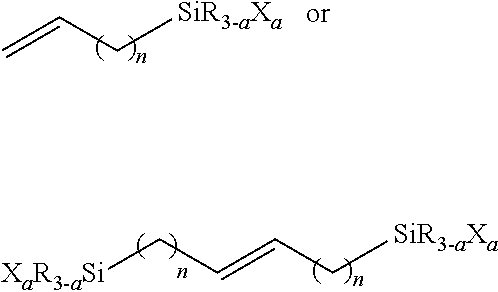Method for preparing low molecular weight polymers
a low molecular weight, polymer technology, applied in the direction of group 4/14 element organic compounds, chemistry apparatus and processes, organic chemistry, etc., can solve the problem of difficult, using known methods, to control the molecular weight of the product of depolymerization, and high proportion of non-functionalized cyclic species end groups
- Summary
- Abstract
- Description
- Claims
- Application Information
AI Technical Summary
Benefits of technology
Problems solved by technology
Method used
Image
Examples
experiment i
Sample 1
[0062]A first poly(butadiene) was prepared by polymerizing 1,3-butadiene in hexanes with an n-butyllithium initiator. The resulting polymer had a number average molecular weight of about 210 kg / mole and a vinyl content of about 9 mole percent.
Sample 2
[0063]A second poly(butadiene) was prepared by polymerizing 1,3-butadiene in hexanes with an n-butyllithium initiator. The resulting polymer had a number average molecular weight of about 200 kg / mole and a vinyl content of about 24 mole percent.
experiment ii
[0064]The polymers of Experiment I were divided into three samples each to form six samples, which will be referred to as Samples 1A, 1B, and 1C, and Samples 2A, 2B, and 2C. Each sample was then hydrogenated by contacting the polymer with tosylsulfonylhydrazide (TSC). The amount of TSC employed in each sample is provided in Table I. The amount of TSC provided in Table I includes the equivalents of TSC per double bond within the polymer (i.e., 1 equivalent TSC per butadiene mer unit). Also provided in Table I is the percent hydrogenation that was achieved; i.e., the mole percent of double bonds removed or hydrogenated by the process.
[0065]
TABLE ISample1A1B1C2A2B2CPre-hydrogenation9%9%9%24%24%24%vinyl contentAmount of TSC1.01.62.01.61.52.0(eqv / double bond)Hydrogenation (%)799999.986.39999.9
experiment iii
[0066]Portions of Samples 1A and 2A were dissolved in toluene to a 3% solids concentration and maintained in an inert atmosphere under nitrogen. To each sample was added 0.5 milliequivalents of ruthenium[1,3-bis-(2,4,6-trimethylphenyl)-2-imidazolidinylidene]dichloro(phenylmethylene) (tricyclohexylphosphine) per mole of polymer, and 0.02 moles of trans-3-hexene per mole of polymer. The solution was maintained at 50-60° C. for about 1-2 hours under nitrogen while stirring. The viscosity of the solution was monitored, and a reduction in viscosity was observed.
PUM
| Property | Measurement | Unit |
|---|---|---|
| temperature | aaaaa | aaaaa |
| temperature | aaaaa | aaaaa |
| temperature | aaaaa | aaaaa |
Abstract
Description
Claims
Application Information
 Login to View More
Login to View More - R&D
- Intellectual Property
- Life Sciences
- Materials
- Tech Scout
- Unparalleled Data Quality
- Higher Quality Content
- 60% Fewer Hallucinations
Browse by: Latest US Patents, China's latest patents, Technical Efficacy Thesaurus, Application Domain, Technology Topic, Popular Technical Reports.
© 2025 PatSnap. All rights reserved.Legal|Privacy policy|Modern Slavery Act Transparency Statement|Sitemap|About US| Contact US: help@patsnap.com



